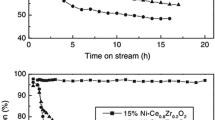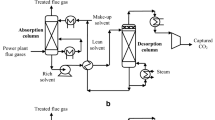Abstract
In this paper, a feasibility study for the application of chemical-looping combustion (CLC) instead of fired furnace for synthesis gas production during methanol synthesis in an industrial-scale conventional steam reformers (CSR) has been considered. The aims are the prevention of large emission of CO2 to atmosphere and enhancement of synthesis gas production. For this purpose, employment of Ni18–Al2O3, Ni40–Al2O3, and Fe45–Al2O3 oxygen carrier (OC) has been investigated. Simulation results show that complete oxidation and reduction of OC occurs in air reactor and fuel reactor (FR), respectively. Also, combustion efficiency reaches to 1 in the FR part of CLC-SR with all types of OCs. Utilizing CLC instead of fired furnace enhances CH4 conversion and H2 yield in SR side of CLC-SR. Results indicate that in CLC-SR, CH4 conversion is equal to 26.4, 27.96, and 26.33 % via Ni18–Al2O3, Ni40–Al2O3, and Fe45–Al2O3 OC, respectively, in comparison with 26 % in CSR. Slightly higher conversion is observed with Ni40–Al2O3, i.e., from 26 % to almost 28 %. Synthesis gas production increases from 3633 kmol h−1 in CSR to 3639, 3868, and 3673 kmol h−1 in CLC-SR via Ni18–Al2O3, Ni40–Al2O3, and Fe45–Al2O3 OC, respectively. Results illustrate that by increasing FR feed temperature from 800 to 1000 K, CH4 conversion in SR side increases 4.99, 7.93, and 4.57 % by using Ni18–Al2O3, Ni40–Al2O3, and Fe45–Al2O3 OC, respectively, in comparison with CSR. Also, synthesis gas production enhances 15 and 26.01 % via Ni18–Al2O3, Ni40–Al2O3, and Fe45–Al2O3 OC, respectively, in comparison with CSR.
Similar content being viewed by others
Abbreviations
- A c :
-
Cross-sectional area (m2)
- A i :
-
Inside area of inner tubes (m2)
- A o :
-
Outside area of inner tubes (m2)
- a v :
-
Specific surface area of catalyst pellet (m2 m−3)
- C t :
-
Total concentration (mol m−3)
- C p :
-
Specific heat of the gas at constant pressure (J mol−1)
- d p :
-
Particle diameter (m)
- D i :
-
Tube inside diameter (m)
- D o :
-
Tube outside diameter (m)
- D ij :
-
Binary diffusion coefficient of component i in j (m2 s−1)
- D im :
-
Diffusion coefficient of component i in the mixture (m2 s−1)
- D o :
-
Tube outside diameter (m)
- E a :
-
Activation energy (J mol−1)
- F i :
-
Flow rate of component I (mol s −1)
- F b :
-
Molar flow in bubble phase (mol s −1)
- F e :
-
Molar flow in emulsion phase (mol s −1)
- h f :
-
Gas–solid heat transfer coefficient (Wm−2 K−1)
- h i and h o :
-
Heat transfer coefficient between fluid phase and reactor wall in exothermic and endothermic sides with convection (Wm−2 K−1)
- k 1 :
-
Reaction rate constant for the first rate equation (mol kg−1 s−1)
- k 2 :
-
Reaction rate constant for the second rate equation (mol kg−1s−1)
- k 3 :
-
Reaction rate constant for the third rate equation (mol kg−1 s−1)
- k i :
-
Rate constant of reaction i (mol kg−1 s−1bar −1/2)
- k g,i :
-
Mass transfer coefficient for component i (ms−1)
- K :
-
Conductivity of fluid phase (Wm−1 K−1)
- K w :
-
Thermal conductivity of reactor walls (Wm−1 K−1)
- k 0i :
-
Pre-exponential factor of chemical reaction rate constant for oxidation and reduction of oxygen carriers (\({{\rm mol}^{{\rm 1-n}}{\rm m}^{{\rm 3n-2}}{\rm s}^{-1}}\))
- L :
-
Reactor length (m)
- M i :
-
Molecular weight of component i (g mol−1)
- n :
-
reaction order for oxidation and reduction of OCs
- P :
-
Total pressure (Pa)
- P i :
-
Partial pressure of component i (Pa)
- R :
-
Universal gas constant (J mol−1K−1)
- Re :
-
Reynolds number
- Sc i :
-
Schmidt number of component i
- T :
-
Temperature (K)
- t :
-
Time (s)
- u :
-
Superficial velocity of fluid phase (ms−1)
- u g :
-
Linear velocity of fluid phase (ms−1)
- U :
-
Overall heat transfer coefficient between exothermic and endothermic sides based on convection (W m−2 K−1)
- U AS :
-
Overall heat transfer coefficient between AR side and SR side (Wm−2 K−1)
- U AF :
-
Overall heat transfer coefficient between AR side and FR side (Wm−2 K−1)
- X OC :
-
Conversion of oxidized OCs
- y i :
-
Mole fraction of component i
- z :
-
Axial reactor coordinate (m)
- \({\mu}\) :
-
Viscosity of fluid phase (kgm−1 s−1)
- \({\rho}\) :
-
Density of fluid phase (kgm−3)
- \({\rho_{{\rm b}}}\) :
-
Density of catalytic bed (kgm−3)
- \({\tau_{{\rm i}}}\) :
-
Time needed for full conversion (s)
- \({\nu_{{\rm ci}}}\) :
-
Critical volume of component i (cm3 mol−1)
- \({\Delta H_{{\rm f,i}}}\) :
-
Enthalpy of formation of component i (J mol−1)
- \({\varepsilon_{{\rm b}}}\) :
-
Void fraction of catalytic bed
- \({\delta}\) :
-
Bubble phase volume as a fraction of total bed volume
- \({\gamma}\) :
-
Volume fraction of catalyst occupied by solid particle in bubble
- \({\phi}\) :
-
OC circulation flow rate to fuel flow rate
- \({\eta_{{\rm c}}}\) :
-
combustion efficiency
- \({\eta}\) :
-
effectivenessfactor
- g :
-
In bulk gas phase
- s :
-
At surface catalyst
- 0:
-
Inlet conditions
- i :
-
Chemical species
- j :
-
Reactor side
- AR:
-
Air reactor
- FR:
-
Fuel reactor
- SR:
-
Steam reforming
- OC:
-
Oxygen carrier
References
Ventura C., Azevedo J.L.T.: Development of a numerical model for natural gas steam reforming and coupling with a furnace model. Int. J. Hydrog. Energy 35, 9776–9787 (2010)
Meisen A., Shuai X.: Research and development issues in CO2 capture. Energy Convers. Manag. 38, 37–42 (1997)
IPCC: Climate change: synthesis report (2007)
Song Q., Xiao R., Deng Z., Zhang H., Shen L., Xiao J., Zhang M.: Chemical-looping combustion of methane with CaSO4 oxygen carrier in a fixed bed reactor. Energy Convers. Manag. 49, 3178–3187 (2008)
Lewis, W.K.; Gilliland, E.R.: Production of pure carbon dioxide. U.S. Patent Office, Number 2, 665, 972 (1954)
Ishida M., Yamamoto M., Ohba T.: Experimental results of chemical-looping combustion with NiO/NiAl2 O4 particle circulation at 1200°C. Energy Convers. Manag. 43, 1469–1478 (2002)
Abad A., Adánez J., García-Labiano F., de Diego L.F., Gayán P.: Modeling of the chemical-looping combustion of methane using a Cu-based oxygen-carrier. Combust. Flame 157, 602–615 (2010)
Brahimi D., Choi J.H., Youn P.S., Jeon Y.W., Kim S.D., Ryu H.J.: Simulation on operating conditions of chemical looping combustion of methane in a continuous bubbling fluidized-bed process. Energy Fuels 26, 1441–1448 (2012)
Lyngfelt A., Leckner B., Mattisson T.: A fluidized-bed combustion process with inherent CO2 separation-application of chemical-looping combustion. Chem. Eng. Sci. 56, 3101–3313 (2001)
Hossain M., de Lasa H.: Chemical-looping combustion (CLC) for inherent CO2 separations—a review. Chem. Eng. Sci. 63, 4433–4451 (2008)
Hossain M.M.: Chemical-looping combustion with gaseous fuels: thermodynamic parametric modeling. Arab. J. Sci. Eng. 39, 3415–3421 (2014)
Moghtaderi B.: Review of the recent chemical looping process developments for novel energy and fuel applications. Energy Fuels 26, 15–40 (2012)
Dueso C., Ortiz M., Abad A., García-Labiano F., de Diego L.F., Gayán P., Adánez J.: Reduction and oxidation kinetics of nickel-based oxygen-carriers for chemical-looping combustion and chemical-looping reforming. Chem. Eng. J. 188, 142–154 (2012)
Abad A., Adánez J., García-Labiano F., de Diego L.F., Gayán P., Celaya J.: Mapping of the range of operational conditions for Cu-, Fe-, and Ni-based oxygen carriers in chemical-looping combustion. Chem. Eng. Sci. 62, 533–549 (2007)
Rydén M., Arjmand M.: Continuous hydrogen production via the steam–iron reaction by chemical looping in a circulating fluidized-bed reactor. Int. J. Hydrog. Energy 37, 4843–4854 (2012)
Peltola P., Ritvanen J., Tynjälä T., Pröll T., Hyppänen T.: One-dimensional modeling of chemical looping combustion in dual fluidized bed reactor system. Int. J. Greenh. Gas Control 16, 72–82 (2013)
Wolf J., Anheden M, Yan J.: Comparison of nickel- and iron-based oxygen carriers in chemical looping combustion for CO2 capture in power generation. Fuel 84, 93–1006 (2005)
Marx K., Bolhar-Nordenkampf J., Proll T., Hofbauer H.: Chemical looping combustion for power generation—concept study for a 10 MWth demonstration plant. Int. J. Greenh. Gas Control 5, 1199–1205 (2011)
Rydén M., Lyngfelt A.: Using steam reforming to produce hydrogen with carbon dioxide capture by chemical-looping combustion. Int. J. Hydrog. Energy 31, 1271–1283 (2006)
Ortiz M., Gayán P., de Diego L.F., García-Labiano F., Abad A., Pans M.A., Adánez J.: Hydrogen production with CO2 capture by coupling steam reforming of methane and chemical-looping combustion: use of an iron-based waste product as oxygen carrier burning a PSA tail gas. J. Power Sources 196, 4370–4381 (2011)
Rahimpour M.R., Hesami M., Saidi M., Jahanmiri A., Farniaei M., Abbasi M.: Methane steam reforming thermally coupled with fuel combustion: application of chemical looping concept as a novel technology. Energy Fuels 27, 2351–2362 (2013)
Ramaswamy R.C., Ramachandran P.A., Dudukovi’c M.P.: Recuperative coupling of exothermic and endothermic reactions. Chem. Eng. Sci. 63, 1654–1667 (2008)
Abashar M.: Coupling of steam and dry reforming of methane in catalytic fluidized bed membrane reactors. Int. J. Hydrog. Energy 8, 799–808 (2004)
Abo-Ghander N.S., Grace J.R., Elnashaie S.S.E.H., Lim C.J.: Modeling of a novel membrane reactor to integrate dehydrogenation of ethyl benzene to styrene with hydrogenation of nitrobenzene to aniline. Chem. Eng. Sci. 63, 1817–1826 (2008)
Rahimpour M.R., Dehnavi M.R., Allahgholipour F., Iranshahi D., Jokar S.M.: Assessment and comparison of different catalytic coupling exothermic and endothermic reactions: a review. Appl. Energy 99, 496–512 (2012)
Abbasi M., Farniaei M., Rahimpour M.R., Shariati A.: Enhancement of hydrogen production and carbon dioxide capturing in a novel methane steam reformer coupled with chemical looping combustion and assisted by hydrogen perm-selective membranes. Energy Fuels 27, 5359–5372 (2013)
Xu J., Froment G.F: Methane steam reforming, methanation and water–gas shift: I. Intrinsic kinetics. AIChE J. 35, 88–96 (1989)
Xu G., Li P., Rodrigues A.: Sorption enhanced reaction process with reactive regeneration. Chem. Eng. Sci. 57, 3893–3908 (2002)
Farniaei M., Abbasi M., Kabiri S.: Production of hydrogen, methanol and benzene simultaneously in an industrial scale reactor by considering effect of flow type regimes. Arab. J. Sci. Eng. 39, 8477–8489 (2014)
Wilke C.R.: Estimation of liquid diffusion coefficients. Chem. Eng. Prog. 45, 218–224 (1949)
Sit S.P., Grace J.R.: Effect of bubble interaction on inter-phase mass transfer in gas fluidized beds. Chem. Eng. Sci. 36, 327–335 (1981)
Mori S., Wen C.Y.: Estimation of bubble diameter in gaseous fluidized beds. AIChE J. 21, 109–115 (1975)
Kunii D., Levenspiel O.: Fluidization Engineering. Wiley, New York (1991)
Reid R.C., Sherwood T.K., Prausnitz J.: The Properties of Gases and Liquids, 3rd edn. McGraw-Hill, New York (1977)
Smith J.M.: Chemical Engineering Kinetics. McGraw-Hill, New York (1980)
Author information
Authors and Affiliations
Corresponding author
Rights and permissions
About this article
Cite this article
Abbasi, M., Farniaei, M., Rahimpour, M.R. et al. A Feasibility Study for Synthesis Gas Production by Considering Carbon Dioxide Capturing in an Industrial-Scale Methanol Synthesis Plant. Arab J Sci Eng 40, 1255–1268 (2015). https://doi.org/10.1007/s13369-015-1598-9
Received:
Accepted:
Published:
Issue Date:
DOI: https://doi.org/10.1007/s13369-015-1598-9




